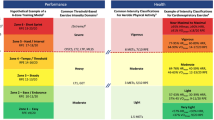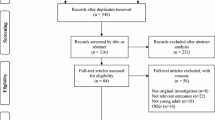Abstract
The purpose of this study was to investigate walking economy in response to steady-state locomotion in adult males with Down syndrome (DS) and in healthy controls. Twelve participants with DS (34.5 ± 7.0 years) and 11 non-disabled controls (34.3 ± 8.7 years) performed submaximal (0% grade, 2.5 km h−1 for 8 min) and maximal treadmill tests with metabolic and heart-rate measurements. For submaximal walking, submaximal oxygen uptake (VO2) (9.1 vs. 9.5 mL kg−1 min−1), net VO2 (5.9 vs. 5.4 mL kg−1 min−1) were not different between the groups (P > 0.05). However, oxygen-pulse (6.6 vs. 8.6 mL/beat) was lower and relative work intensity (44.6 vs. 19.9% of max) was higher in individuals with DS compared to controls (P < 0.05). Findings indicate similar walking economy between groups. Nevertheless, participants with DS exercised at lower submaximal oxygen-pulse and higher percentage of VO2peak. Therefore, despite similar walking economy, participants with DS have lower cardiorespiratory function than controls for a given steady-state treadmill speed.
Similar content being viewed by others
References
Ammirati A, Marino B, Annicchiarico M, Ferraza A, Affinito V, Ragonese P (1991) Sindromi di Down senza cardiopatia congenita: E’ realmente normale l’anatomia eccocardiografica? G Ital Cardiol 21:55
Bergman B, Brooks B (1999) Respiratory exchange ratios during graded exercise in fed and fasted trained and untrained man. J Appl Physiol 86(2):479–487
Browning R, Kram R (2005) Energetic cost and preferred speed of walking in obese vs normal weight women. Obes Res 13:891–899. doi:10.1038/oby.2005.103
Cavanagh P, Williams K (1982) The effect of stride length variation on oxygen uptake during distance running. Med Sci Sports 14(1):30–35
Cavanagh P, Pollock M, Landa J (1977) A biomechanical comparison of elite and good distance runners. Ann N Y Acad Sci 301:328–345. doi:10.1111/j.1749-6632.1977.tb38211.x
Christensen E, Hansen O (1939) Repiratorisher quotient und O2-aufnahme. Skand Arch Physiol 81:180–189
Dubois D, Dubois E (1916) A formula to estimate the approximate surface area if height and weight be known. Arch Intern Med 17:863–871
Fernhall B, Otterstetter M (2003) Attenuated responses to sympathoexcitation in individuals with Down syndrome. J Appl Physiol 94:2158–2165
Fernhall B, Pitetti K (2001) Limitations to physical work in individuals with mental retardation. Clin Exerc Physiol 3:176–185
Fernhall B, Unnithan V (2002) Cardiovascular fitness as related to leg strength in adults with mental retardation. Med Sci Sports Exerc 27:423–428
Fernhall B, Millar A, Tymeson G, Burkett L (1990) Maximal exercise testing of mentally retarded adolescents and adults: reliability study. Arch Phys Med Rehabil 71(13):1065–1068
Fernhall B, Pitetti K, Rimmer J, McCubbin J, Rintala P, Millar A et al (1996) Cardiorespiratory capacity of individuals with mental retardation including Down syndrome. Med Sci Sports Exerc 28(3):366–371. doi:10.1097/00005768-199603000-00012
Friedlander A, Casazza G, Huie M, Horning M, Brooks G (1997) Endurance training alters glucose kinetics in response to the same absolute, but not the same relative workload. J Appl Physiol 82:1360–1369
Goran M, Fields D, Herd S, Weinsier R (2000) Total body fat does not influence maximal aerobic capacity. Int J Obes 24:841–848. doi:10.1038/sj.ijo.0801241
Guerra M, Roman B, Geronimo C, Violan M, Cuadrado E, Fernhall B (2000) Physical fitness levels of physically active and sedentary active individuals with Down syndrome. Adapt Phys Activ Q 17:310–321
Menz H, Lord S, Fitzpatrick R (2003) Age-related differences in walking stability. Age Ageing 32:137–142. doi:10.1093/ageing/32.2.137
Morgan D, Craib M (1992) Physiological aspects of running economy. Med Sci Sports Exerc 24(4):456–461
Parker A, Bronks R, Synder C Jr (1985) Walking patterns in Down’s syndrome. J Ment Defic Res 30:317–330
Pitetti K, Boneh S (1995) Cardiovascular fitness as related to leg strength in adults with mental retardation. Med Sci Sports Exerc 27:423–428. doi:10.1249/00005768-199503000-00020
Pollock M (1977) Submaximal and maximal work capacity of elite distance runners. Part I: Cardiorespiratory aspects. Ann N Y Acad Sci 301:310–322. doi:10.1111/j.1749-6632.1977.tb38209.x
Rosengren K, McAuley E, Mihalko S (1998) Gait adjustments in older adults: activity and efficacy influences. Psychol Aging 13:375–386. doi:10.1037/0882-7974.13.3.375
Rosenquist G, Sweeney L, Amsel J, McAllister H (1974) Enlargement of the membranous ventricular septum: an internal stigma of Down’s syndrome. J Pedod 85:490–493. doi:10.1016/S0022-3476(74)80450-6
Rubin S, Rimmer J, Chicoine B, Braddock D, McGuire E (1998) Overweight prevalence in persons with Down syndrome. Ment Retard 36:175–181. doi:10.1352/0047-6765(1998)036<0175:OPIPWD>2.0.CO;2
Smith B, Ulrich B (2008) Early onset of stabilizing strategies for gait and obstacles: older adults with Down syndrome. Gait Posture 28:448–455. doi:10.1016/gaitpost.2008.02.002
Smith B, Kubo M, Black D, Holt K, Ulrich B (2007) Effect of practice of a novel-task walking on a treadmill: preadolescents with and without Down syndrome. Phys Ther 87:766–777. doi:10.2522/ptj.2007.87.2.232
Spyropoulos P, Pisciotta J, Pavlou K, Cairns M, Simon S (1991) Biomechanical gait analysis in obese men. Arch Phys Med Rehabil 72:1065–1070
Stanish H, Draheim C (2005) Walking habits of adults with mental retardation. Ment Retard 43:421–427. doi:10.1352/0047-6765(2005)43[421:WHOAWM]2.0.CO;2
Thomas D, Fernhall B, Grant H (1999) Changes in running economy during a 5-km run in trained men and women runners. J Strength Cond Res 13(2):456–461. doi:10.1519/1533-4287(1999)013<0162:CIREDA>2.0.CO;2
Wasserman K, Hansen J, Sue D, Stringer W, Whipp B (2005a). Measurements during integrative cardiopulmonary exercise testing. In: Principles of exercise testing and interpretation—including pathophysiology and clinical applications, 4th edn. Lippincott Williams & Wilkins, Philadelphia, pp 90–92
Wasserman K, Hansen J, Sue D, Stringer W, Whipp B (2005b) Normal values. In principles of exercise testing and interpretation—including pathophysiology and clinical applications, 4th edn. Lippincott Williams & Wilkins, Philadelphia, pp 161–182
Whipp B (1971) Rate constant for the kinetics of oxygen uptake during light exercise. J Appl Physiol 30(2):261–263
Whitt-Glover M, O’Neill K, Stettler N (2006) Physical activity patterns in children with and without Down syndrome. Pediatr Rehabil 9:158–164. doi:10.1080/13638490500353202
Winter D (1990). Mechanical work, energy, and power. In: Biomechanics and motor control of human movement, 2nd edn. Wiley, New York, pp 103–139
Acknowledgments
This study was supported by a grant from the Center of Human Performance from the Human Kinetics Faculty in Lisbon, Portugal.
Author information
Authors and Affiliations
Corresponding author
Rights and permissions
About this article
Cite this article
Mendonça, G.V., Pereira, F.D. & Fernhall, B. Walking economy in male adults with Down syndrome. Eur J Appl Physiol 105, 153–157 (2009). https://doi.org/10.1007/s00421-008-0884-6
Accepted:
Published:
Issue Date:
DOI: https://doi.org/10.1007/s00421-008-0884-6




